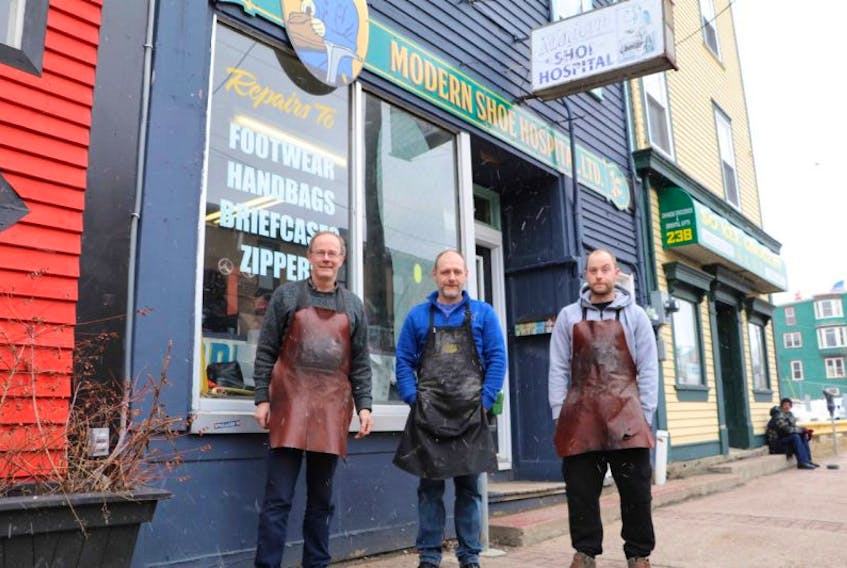
Having footwear repaired not only saves money, but keeping those discarded shoes and boots out of the landfills helps the environment, says Wright, owner of Modern Shoe Hospital on Duckworth Street in St. John’s.
A repair — such as a new sole in a shoe or new zipper in a long boot — could mean many more years of use for your favourite footwear.
“A lot of manufacturers are not willing to take footwear back and repair it because it’s a time-consuming process. It’s slower to rebuild a pair than to make a new pair,” says Wright.
“But some manufacturers, like Allen Edmonds in the United States, they have a factory in Wisconsin making nice leather shoes, but they also recraft, so you can send the shoes back to them and they will rebuild them for you.

“That’s what we do. We rebuild shoes. The unfortunate thing is a lot of the shoes we see coming in now are like planned obsolescence, they are made with polyurethane foams that disintegrate and break down. The manufacturers well tell you that’s for the benefit of the landfill, so they break down quicker. But really, you shouldn’t have to throw it away because the soles have worn out. And a lot of them you can’t fix these days because of the proprietary way they are made. You would have to have an identical sole to be able to sew it back on. So, some of them pay lip service to the environmental issues but they are not really helping it.
“In a lot of cases, you are going to have to throw a boot away long before you should have to because you can’t replace the sole.”
Downtown footprint
Wright’s family has operated Modern Shoe Hospital in St. John’s since the 1920s. The store has been at its current location on Duckworth Street since 1951, having operated previous to that further east on Duckworth.
Entering the store today is like a step back in time to the early days of the city’s cobbler shops. The interior seems to not have changed much over the years.
Wright, wearing a thick brown work apron, steps out from the noise of operating machinery at the back of the shop and stands at the counter. Behind him is a wall of aged, green-painted wooden shelves filled with repaired footwear tagged and ready to be picked up.
In the work area at the rear of the store, there are well-worn benches and aged machinery that’s still in top working condition. There are containers of glue and other shoe-repair products, as well as knives, scissors, clamps and tools on the benches. Bits of rubber and material from footwear being worked on are littered on the floor and over work spaces.
The business was started by Wright’s great-uncle, Sid Wright, and his brother-in-law Earnest Winsor.
Kevin Wright’s grandfather, Jonas Wright, who was a fisherman and sawmill operator in Lumsden, moved his family to St. John’s during the Second World War.
As a young man, Kevin Wright’s father, Les Wright, took a job working at St. John’s harbour.
“My dad was working on the finger piers at the harbour and he almost got killed by a load of fill,” Wright said. “His uncle Sid told Dad he will see if he could get him a job at the shoe hospital. They were operating in a building across from the War Memorial on Duckworth Street at the time.
“Dad got the job, liked it and stuck with it. This building became available in 1951 and Ernest and my dad bought it between them. When Ernest later got out of the business, he sold his interest to Dad.”
Just as Kevin Wright continued on in the business with his father, eventually taking over from him, Kevin’s son, Adam, works at the store. Longtime employee Jim Whey rounds out the workforce.
Generations of skill
Wright says the shoe repair skills passed down to through the family over the years likely originated from cobblers in Montreal.
“Ernest Winsor learned the trade of shoe repair in Montreal in the 1920s or earlier, from what I can gather,” Wright said.
“There use to be shoe manufacturing down here. Parker and Monroe made shoes and there were probably half a dozen cobbler shops around town. That was more in the era before the Second World War.”
With the start of the Second World War, demand for new footwear and repairs increased as mainland factories were converted to making supplies for the war effort.
In addition to local demand growing, sailors from visiting ships came to local cobblers looking for footwear.
“A lot of the sailors who were coming into port, they use to get Wellington boots made, which were simple pull-on boots so they could kick them off fast if they had to get off the ship,” he said.
“Dad and the others made those boots during the war.”
When the Second World War ended and mainland factories turned their focus back to consumer production, local businesses like Modern Shoe Hospital had to return to shoe repair as they could no longer compete in the new shoe market.
“The shoes back then, even when I first came here in the early 1970s, were pretty well made and rebuildable. They were Goodyear welted construction for most of the men’s shoes, and it was only a matter off cutting off the old leather sole, cutting out a new one, gluing it in place and running it around on the sewing machine — a specialized stitcher for sewing on the soles,” Wright explained.
“And same with the heels, a Goodyear Wingfoot heel and cat paw heel. They had washers built in so you’d just pull off the old one, glue a new one in place, nail it on and trim it off. You could do a repair job in less than half an hour if everything was going right.”
Handbags and hockey bags
These days it’s not all about repairing shoes and boots for Modern Shoe Hospital.
Want a new zipper put in your hockey bag, new palms in your worn hockey gloves? How about getting a repair on that piece of luggage damaged during your last holiday trip?
In addition to footwear, requests for everything from backpack repairs to skate sharpening and hockey equipment repair are among the business Wright sees coming through his door.
They have life-long customers such as Clyde Flight — Wright’s Grade 7 homeroom teacher who happened into the store during the interview — and many new customers looking to extend the life of a favourite pair of shoes or boots.
“There are really no slack periods here anymore,” Wright says.
“We do zipper replacements in everything from long boots to hockey bags. Sometimes it’s just the puller on the zipper that needs replacement. We repair a lot of handbags, either shortening the straps or fixing the zippers.”
Wright believes there should be more repair shops in the province. He said too many items are going into the landfill that could be easily repaired.
And he believes that manufacturers should build more common, everyday items to a higher quality so that they can be repaired.
“Just this week past we repaired a pair of Birkenstock sandals. They are $140 or $150 per pair, so to resole them between $40 to $50, it’s a worthwhile repair on something like that. …
“A lot of people think shoes are cheap, and they are if you get them on sale or you buy them somewhere like a discount warehouse. But when you get into more than $100 for shoes or boots, you should really be looking into getting them repaired when they are worn,” Wright.
“Sometimes the repair makes them better and last longer than when they were first made.”









